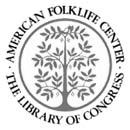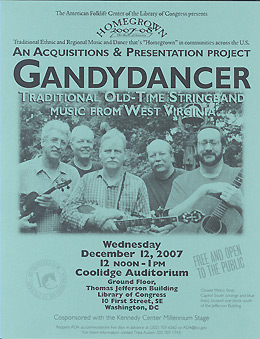| |
|||
|
home >>
event archive >> homegrown concert series archive >> concert flyer for gandydancer 2007The American Folklife Center at the Library of Congress presentsThe Homegrown 2007 Concert Series
|
|
Today’s West Virginia old-time musicians have a long-held tradition of fiddle and banjo music. Early nineteenth-century accounts from the region document both African and European people playing traditional music on fiddles and banjos. People of Scots-Irish, English and German heritage make up the majority of the population, but African Americans were quite influential on the traditional music of the region. Through the latter eighteenth and the nineteenth century, string music for dancing, banjo tunes, fiddle tunes, airs, ballads, folksongs and spirituals sustained and entertained people engaged in taming the frontier.
At the turn of the 20th century, mail order catalogs began reaching the more remote areas of the region. Guitars and mandolins (as well as “factory” fiddles and banjos) became accessible to country musicians. While the mandolin was slow to catch on at first, guitars were widely accepted by the 1920s, providing rhythm for dancing to string music, and freeing up the fiddles to put more melody and less rhythm in the bowing.When string music became available on 78 RPM records, distinct regional styles became blurred. At the same time, the early commercial recordings allowed some of the finest regional traditional music to be documented for the first time in a more-or-less permanent way.
By the 1930s, the stringband tradition became entrenched in the southern uplands, including West Virginia, through widely distributed recordings featuring talented artists. This was further bolstered by the radio through live music broadcasts from studios around the state, with Charleston (WCHS), Fairmont (WMMN), and Bluefield (WHIS) being major players. These shows were sponsored by companies hawking household products, medicines, and even baby chickens. Later, through theater shows such as the Wheeling Jamboree, the music maintained a devoted audience. In West Virginia, string music played by such groups as the Kessinger Brothers, the Tweedy Brothers, Cap Andy and Flip, the Blue Bonnet Girls, Jake Taylor’s Rail Splitters, the Trading Post Gang, the West Virginia Mountain Boys, the Coonhunters and many, many more, provided live radio with a wealth of talent.
Through this period of the commercialization of stringband music, a strong adherence to traditional old-time string music styles was kept alive by rural individuals. These players, many of whom lived into the late twentieth and the twenty-first century, like Melvin Wine, the Hammons Family, the Carpenter family fiddlers, and scores of others, were no doubt influenced in some way by the widespread commercialization, but at the same time they remained true to the music of their “people.” They chose to play the older music, not because they were not exposed to more modern music, but because they valued the old tunes and songs and the way they were played by ancestors.
Today, following a renewed interest in old-time music that began over forty years ago, there are many players of the old music. Everything from old solo fiddle tunes to stringband music that was played commercially and recorded eighty years ago, is now being actively played and performed. Whether for square dances, at fiddle contests, or at any of the traditional music festivals and gatherings that promote the older sounds, the string music of West Virginia is alive and well.
Gandydancer
Gandydancer features five respected musicians with 200 years of combined music experience. Each of the members is a champion multi-instrumentalist, and they have known one another and played together in different combinations for over 20 years. Dave Bing of Harmony, West Virginia is a violin-maker who has taught extensively. His crooked fiddle tunes evoke another time and place. Gerry Milnes of Elkins works at the Augusta Heritage Center and has collected, and played, old-time music for forty years. Jim Martin of St.Albans, West Virginia is an accomplished bass player and sings bass on the band’s quartet numbers. Ron Mullennex of Bluefield, Virginia plays claw hammer banjo and mandolin in the band and is an experienced teacher of the old-time music. Mark Payne of Winfield, West Virginia is sought out for his rock-solid guitar work and three-finger style banjo playing.
The band plays string music from the various eras outlined above. From solo fiddle tunes to early bluegrass numbers, the band has wide interests. Much of their repertoire consists of unusual tunes and songs collected in the last thirty years from traditional musicians and singers. But they also render pieces from the early bluegrass era of the forties and fifties. Members of the band play the fiddle and banjo in various styles, a key to the age of the tunes. Some tunes and songs require the older clawhammer or down-stroke banjo style from older black tradition. However their repertoire includes the use of the three finger bluegrass or “Scruggs” style as well, and these variations present not only a great span of time, but also showcase the versatility of the musicians in the band.
Gerald Milnes
Augusta Heritage Center
Davis and Elkins College
Elkins, West Virginia
 The American Folklife Center was created by Congress in 1976 and placed at the Library of Congress to “preserve and present American Folklife” through programs of research, documentation, archival preservation, reference service, live performance, exhibition, public programs, and training.The Center includes the American Folklife Center Archive of folk culture, which was establishedin 1928 and is now one of the largest collections of ethnographic material from the United States and around the world. Please Visit our web site at http://www.loc.gov/folklife/.
The American Folklife Center was created by Congress in 1976 and placed at the Library of Congress to “preserve and present American Folklife” through programs of research, documentation, archival preservation, reference service, live performance, exhibition, public programs, and training.The Center includes the American Folklife Center Archive of folk culture, which was establishedin 1928 and is now one of the largest collections of ethnographic material from the United States and around the world. Please Visit our web site at http://www.loc.gov/folklife/.
| |||

